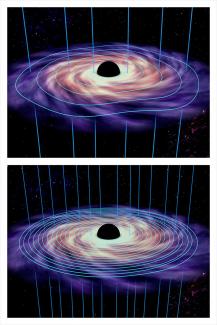Graduate student Greg Salvesen, JILA Collaborator Jake Simon (Southwest Research Institute), and Fellows Phil Armitage and Mitch Begelman decided they wanted to figure out why swirling disks of gas (accretion disks) around black holes often appear strongly magnetized. They also wanted to figure out the mechanism that allowed this magnetization to persist over time. In the process, they hoped to explain some intriguing observations of super-gale force winds blown off of some black-hole accretion disks. So the researchers created supercomputer simulations that allowed them to come up with some interesting ideas about the behavior of magnetized disks.
What they learned is that if there is a magnetic field that is poking vertically through the black hole’s accretion disk, a wreath-shaped magnetic field will be generated within the accretion disk. And, the stronger the vertical field is, the stronger the magnetic wreath will be inside the gas making up the accretion disk––up to a point.
“What we’ve shown is that to get a very strongly magnetized disk, the wreath-shaped component is dominant,’ said Salvesen. “But you still need that vertical magnetic field, which is subdominant, but very important for the physics that produces and maintains a strong wreath-shaped magnetic field.”
Salvesen explained that there are generally two types of black holes that sometimes have accretion disks: supermassive black holes (at the center of each galaxy) with masses of millions to billions of Suns and stellar-sized black holes with masses of about 5 to 30 Suns that are littered throughout every galaxy. Light coming from these accretion disks helps astrophysicists understand both the properties of black holes and the physics of the disks.
“There have been observations recently that are suggestive of some disks being strongly magnetized,” Salvesen explained. “But the most compelling observations are the fast winds we sometimes see coming from the disks. These winds travel at a few percent of the speed of light and are about 10,000 times more powerful than the strongest hurricane winds on Earth!”
The winds must be launched away from the disks by some kind of pressure. There are three possible mechanisms that could create winds: thermal pressure from hot gas; radiation pressure from light; or pressure from magnetic fields. Salvesen is focusing on the pressure from magnetic fields.
“Radiation and thermal pressure often can’t cut it, because they can’t make a wind powerful enough,” he said. “In these cases, the magnetic fields must be responsible for producing the winds we observe coming off the disk.”
Consequently, Salvesen decided to further explore the formation of magnetic fields in black hole accretion disks. What he discovered is fascinating.
“If you have a disk that is initially not turbulent and then you thread it with a vertical magnetic field, an instability will generate turbulence within the disk,” he said. “Even the very weakest field will cause the disk to become turbulent. But, if that vertical magnetic field is too strong, then this instability won’t happen. The vertical magnetic field has to be just right––strong, but not too strong.”
The vertical field needs to be just strong enough to create a very strong magnetic wreath. The magnetic wreath then governs the behavior (and the physics) of the disk from then on, so long as a vertical magnetic field remains in place. In black-hole accretion disks where such conditions can exist, strong magnetic wreaths may play a role in producing extremely fast winds that can be observed by Earthlings hundreds of light years away.––Julie Phillips




